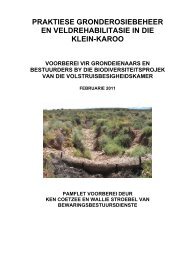REHABILITATION: REHABILITATION: A QUICK GUIDE A ... - saobc
REHABILITATION: REHABILITATION: A QUICK GUIDE A ... - saobc
REHABILITATION: REHABILITATION: A QUICK GUIDE A ... - saobc
You also want an ePaper? Increase the reach of your titles
YUMPU automatically turns print PDFs into web optimized ePapers that Google loves.
Figure 5A illustrates the construction of hand-made hollows suitable for treating<br />
capped, bare areas with uneven terrain. The curved section lies in the downstream<br />
direction of water flow and helps to dam runoff water. The hard soil capping is<br />
loosened with a pick to a depth of the pick tine. The loosened soil is then shoveled<br />
onto the curved edge to form a low earth retaining wall. These hollows can be<br />
made 2m apart in rows, which are 1,5m apart. A large number can be made<br />
inexpensively by one person in one day.<br />
If, for example, only 50 hollows are made by hand in one day, and each one holds<br />
50 liters of water, approximately 2 500 liters of rainwater will be held back and will<br />
infiltrate the soil through the hollows. Formerly, all of the 2 500 liters of water would<br />
have been lost into the nearest drainage system with little or no contribution to soil<br />
moisture and the local water table, and this process is known as aridification.<br />
The puddling plough, illustrated in Figure 5B, can be specially made for treating<br />
extensive, capped and exposed areas. This simple implement is drawn by a tractor<br />
and makes a line of small dams which are approximately 1,8m long, 300mm wide<br />
and 250mm deep and the water holding capacity of each is about 136 liters. Rows<br />
of hollows are made 2m apart and must lie across the direction of water flow. In<br />
this way, an entire patch can be worked into a series of hollows, which trap runoff<br />
water after every rainstorm.<br />
It is extremely important that implements such as the puddling-plough are used with<br />
great care in areas that do still have some vegetation cover. It would make very<br />
little sense to rip out the roots, or whole plants, of already established vegetation in<br />
an effort to restore a protective vegetation cover. In areas with widely spaced or<br />
sparse cover, it will be more practical, in between the plants, to cut hollows by hand<br />
so that the existing plants will not be disturbed. It is important to remember that<br />
every individual rooted plant within any restoration area is valuable. They provide<br />
shade for seedlings, intercept raindrops and protect the soil, produce seeds and<br />
organic mulch and harbour a range of micro fauna. These are exactly the services<br />
that are required for restoration of the ostrich camps.<br />
With such an implement and the will to improve large patches of degraded veld,<br />
large volumes of runoff water can be harvested and used for plant establishment.<br />
The groundwater situation of extensive areas of degraded veld can be easily<br />
improved by means of this simple action. Only 100 hollows will ensure the<br />
infiltration of approximately 13 600 liters of precious moisture.<br />
Using a machine with ordinary grader, bulldozer or loader blades and buckets for<br />
constructing small dams is illustrated in Figure 5C. The principle is exactly the<br />
same as for the previous two methods, except that a larger water storage hollow is<br />
made. Rectangular hollows are made with an earth wall on the “downstream side”.<br />
These small dams can be approximately 3 - 4m long, 1,5 - 2m wide and 50cm -<br />
100cm deep.<br />
These larger hollows must be further treated with the application of a 100 – 200mm<br />
layer of organic mulch or fine brush packing. The reason for this is that the soil of<br />
the larger hollow may again seal after the first few rains. The mulch will keep it<br />
moist and encourage new topsoil formation and the germination of seedlings.<br />
10



